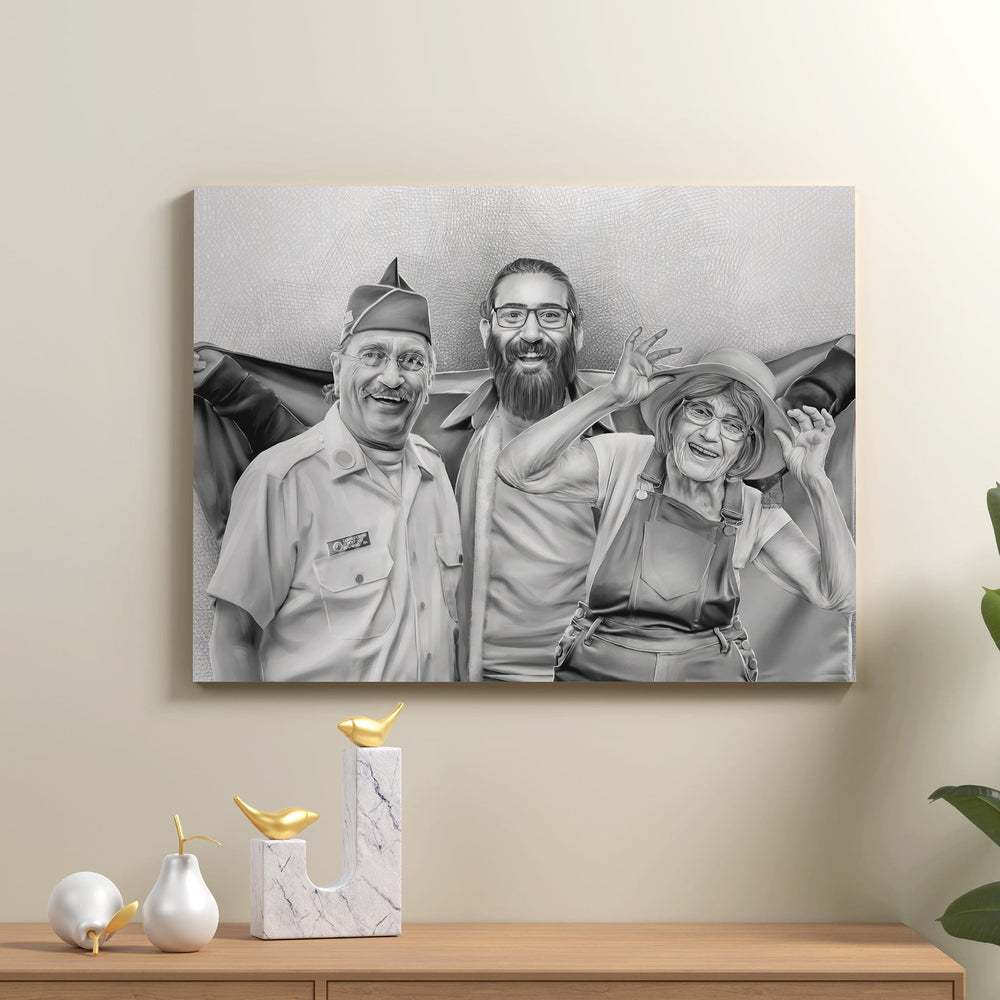What is a Baroque Painting? Characteristics, Examples, and Legacy


Baroque painting, a prominent artistic style from the 17th century, is known for its dramatic use of light and shadow, intense emotions, and grand scale. Originating from Rome, the movement quickly spread throughout Europe, transforming the way art was perceived and created.
In this article, we're diving deep into the world of Baroque painting. We'll unpack its key features, take a look at some iconic examples, and discuss how it has shaped the art landscape even today.
This guide is perfect for both art lovers and those new to the field, offering insights into the captivating world of Baroque art. So, prepare to travel back in time and discover the drama, intensity, and intricate detail that define Baroque painting.
What is Baroque?
The term "Baroque" designates an artistic movement that originated in Rome and flourished across Europe in the 17th century. The movement was a departure from the restrained and balanced aesthetics of the Renaissance era. Instead, it embraced grandeur, ornamentation, and a heightened sense of drama. The Baroque period was marked by artists' endeavor to evoke profound emotional responses, creating a new level of expressiveness in art.
The Baroque era was a time of exploration and innovation in various fields such as architecture, music, literature, and more. However, it is perhaps most renowned for its impact on visual arts, particularly painting, where it introduced a novel approach to representation, composition, and use of color and light.
Characteristics of Baroque Art
Baroque art is primarily characterized by its dramatic intensity, a sense of movement, and a powerful display of emotions. Artists used deep, rich colors and stark contrasts between light and shadow to imbue their works with a sense of depth and emotional resonance.
One of the defining techniques of this era is "chiaroscuro," a method that employs the dramatic interplay of light and dark to lend a three-dimensional effect to the artwork. Artists also employed complex, often diagonal compositions to suggest movement and action, further enhancing the dynamism of their work.
Additionally, Baroque art is known for its elaborate details and ornamentation, reflecting a desire for extravagance and opulence. It elaborates on the complexity that gives Baroque art its distinctive, dramatic flair.
What defines Baroque paintings?
Baroque paintings are distinguished by their dramatic narratives, meticulous details, and large-scale compositions. Figures within these paintings often appear to be in motion, which amplifies the dramatic impact of the scenes.
The subject matter of Baroque paintings varied widely. Artists depicted everything from biblical accounts and mythological tales to portraits and landscapes. The diversity of subjects allowed artists to explore various aspects of human experience, from the divine and supernatural to the mundane and ordinary.
Another defining feature of Baroque painting is tenebrism, an extreme form of chiaroscuro where the contrast between light and dark areas is highly pronounced. In many Baroque paintings, large portions of the composition are engulfed in shadow, with dramatically lit figures emerging from the darkness. The technique was employed to heighten the emotional impact, creating a sense of drama and tension that draws viewers into the scene.
Baroque paintings are not just artworks; they are theatrical performances captured on canvas, designed to captivate, move, and engage viewers in a deeply personal and emotional experience.
Major Baroque paintings
The Baroque period, a time of artistic innovation and grandeur, produced numerous remarkable paintings that continue to captivate audiences even today. These works are characterized by their dramatic intensity, meticulous attention to detail, and pioneering use of light and shadow.
Let's take a closer look at five of the most significant paintings from this period.
The Conversion of Saint Paul - Caravaggio
Caravaggio's "The Conversion of Saint Paul" is a quintessential Baroque masterpiece. The painting masterfully employs the technique of chiaroscuro to create a stark contrast between light and dark, creating a sense of depth and realism.
It portrays the poignant moment when Saul of Tarsus, then a persecutor of Christians, is struck blind by a divine light on the road to Damascus, leading to his conversion to Christianity. This dramatic narrative is heightened by Caravaggio's exceptional ability to capture human emotion and physicality.
The Night Watch - Rembrandt van Rijn
Another iconic work from the Baroque era is Rembrandt’s "The Night Watch." The piece embodies the dynamism and energy that are characteristic of Baroque art. Its composition is filled with life-size figures captured mid-action, while the artist's skillful use of light and shadow adds drama and depth to the scene. "The Night Watch" is not just a painting; it's a spectacle of movement and vitality.
Las Meninas - Diego Velazquez
Diego Velazquez's "Las Meninas" is a testament to the Baroque fascination with illusion, perspective, and the interplay between reality and artifice. It features a group of figures from the Spanish royal court, with the artist himself included in the scene.
Velazquez's expert manipulation of perspective and reflection invites viewers into a complex narrative, making them active participants in the artwork.
The Triumph of Bacchus - Diego Velazquez
"The Triumph of Bacchus," another renowned painting by Velazquez, is a celebration of the Baroque style's opulence and drama. It depicts the god Bacchus surrounded by revelers, their faces illuminated by an ethereal light.
The use of light, texture, and color in this painting creates a vivid, tangible sense of reality that is characteristic of Baroque art.
The Ecstasy of Saint Teresa - Gian Lorenzo Bernini
While "The Ecstasy of Saint Teresa" by Bernini is technically a sculpture, it is included here for its painterly qualities. The work captures the theatricality and emotional intensity of the Baroque style, depicting Saint Teresa in a state of divine ecstasy.
Bernini's ability to render the play of light on the intricate folds of Saint Teresa's robe brings a painting-like realism to the sculpture, making it a masterpiece of Baroque art.
Impact of Baroque Art and Paintings
The Baroque period, a pivotal time in the history of art, challenged and reshaped the conventional artistic norms through its emphasis on drama, emotion, and realism. This epoch left an indelible impact on the world of art, inspiring countless artists and movements in the centuries that followed.
The Baroque style marked a departure from more passive artistic engagement, encouraging artists to connect with viewers on a profound, emotional level. Works from this era are known for their ability to evoke intense reactions, making each piece not just an object of observation but a deeply immersive experience.
Moreover, the Baroque era introduced innovative techniques such as chiaroscuro and tenebrism, which revolutionized the use of light and shadow in visual arts. These techniques allowed artists to create a sense of depth, volume, and three-dimensionality in their works, significantly expanding the possibilities of artistic representation.
Relevance of Baroque art today
Today, the influence of Baroque art is palpable across various forms of visual arts. From modern and contemporary art to cinema and photography, the grandeur, dynamism, and emotional intensity of the Baroque style continue to resonate.
The enduring legacy of the Baroque period serves as a rich source of inspiration, reminding us of the transformative power of art to move, captivate, and engage audiences in meaningful ways.
Oil Painting

Order Your Oil Painting Here
The benefits of oil painting are numerous and noteworthy. Oil paints offer a rich color depth and a wide range of hues due to their layering and mixing capabilities. They provide flexibility, thanks to their long drying time, giving artists ample opportunity to modify their work.
The durability of oil paint also adds value to the art, making it resistant to elements like dust, light, and water. Moreover, the ability of oil paints to blend smoothly allows for a greater range of color and shading options, enhancing the visual appeal of the artwork. This is why oil paintings often look more valued and expensive.
Custom Canvas Painting

Get Your Custom Canvas Painting Here
Custom canvas painting has surged in popularity as it allows individuals to express personal narratives or sentiments through art. Drawing inspiration from the Baroque period's focus on human emotions and dramatic narratives, custom canvas painting offers a unique platform to tell personal stories through artistic representation.
Paste Portraits

Order Your Pastel Portraits Here
Pastel portraits, characterized by thick layers of paint application, reflect the texture and volume seen in many Baroque paintings. The technique creates a tactile, three-dimensional effect, adding depth and realism to the artwork, much like the richness of Baroque masterpieces.
Family Oil Painting

Get Your Family Oil Painting Here
Family oil paintings are a contemporary nod to the grand, multi-figure compositions prevalent in Baroque art. These paintings capture the essence of familial bonds and individual personalities, creating cherished keepsakes.
Like the Baroque artists, painters of family oil portraits employ light, shadow, and color to breathe life into their subjects, rendering them with a vivid sense of realism.
Couple Canvas Portraits

Order Your Couple Canvas Portraits Here
Couple canvas portraits are a popular form of personalized art today. Drawing on the Baroque tradition of portraying intimate human relationships with intensity and emotion, these portraits capture the unique bond between two individuals.
Whether depicting a quiet moment of connection or a dramatic expression of love, couple canvas portraits embody the emotional depth and dynamism that are the hallmarks of Baroque art.
Preserve Your Precious Memories with Memorialize Art Today!
Art is a powerful tool for remembrance. It captures moments, emotions, and narratives, preserving them for generations to come. Whether it's a custom canvas painting, a family oil portrait, or a couple canvas portrait, personalized art creates a lasting tribute.
Drawing from the depth and dynamism of Baroque art, these pieces can memorialize your unique story in a meaningful, beautiful way. Don't let your memories fade into the past; engrave them in color and texture with Memorialize Art today.
FAQs
What defines Baroque paintings?
Baroque paintings are defined by their dramatic intensity, meticulous attention to detail, and innovative use of light and shadow. Artists of this period often employed techniques such as chiaroscuro and tenebrism to create a sense of depth and realism. Baroque paintings also tend to feature grand compositions, intricate narratives, and emotionally charged scenes.
What characterizes Baroque art?
Baroque art is characterized by its grandeur, dynamism, and emotional depth. It often features elaborate compositions filled with movement and energy. The use of light and shadow plays a crucial role in Baroque art, adding drama and depth to the scenes. Moreover, Baroque art is known for its focus on realism and its ability to evoke intense emotional responses from viewers.
How can you tell if a painting is Baroque?
A painting can be identified as Baroque by several key characteristics. First, look for dramatic contrasts between light and dark areas, a technique known as chiaroscuro. Baroque paintings often depict dynamic, action-filled scenes with a sense of movement.
Realism, both in terms of physical details and emotional portrayal, is another hallmark of Baroque art. Finally, Baroque paintings often have a grand, expansive composition that includes multiple figures and intricate narratives.










